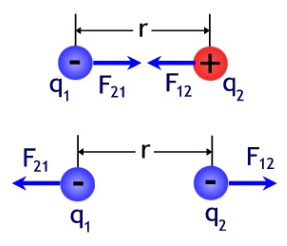
All matter is made of atoms. These atoms are made of elementary particles including protons and electrons. Protons and electrons are special particles because they have a characteristic called charge. Protons are positive and electrons are negative. If an object has more protons than electrons, it has an overall positive charge, and if it has more electrons than protons, it has an overall negative charge. Matter that has the same number of protons as electrons is said to be neutral.
The variable used for charge is q, and the units of charge are Coulombs (C).
Charged objects affect the space around them by creating an electric field. This electric field extends into the space around the charge, and exerts a force on other charged objects. The fact that this electric force can act at a distance classifies it as a field force.

![]() In the following simulation, select "Show E-Field," and then place 3 positive charges in the same spot. The arrows that appear represent the direction of the electric field, and they show the direction a small positive charge would move if it were placed in the field. Click "Clear All," and place 3 negative charges in the same place.
In the following simulation, select "Show E-Field," and then place 3 positive charges in the same spot. The arrows that appear represent the direction of the electric field, and they show the direction a small positive charge would move if it were placed in the field. Click "Clear All," and place 3 negative charges in the same place.
Positive charges attract negative. The positive charge pulls the negative charge toward it and the negative charge pulls the positive charge toward it. Positive charges repel other positive charges and negative charges repel other negative charges. Each of the charges pushes the other charge away from it.

Source: Opposites Attract, Don Bahls, University of Alaska - David Newman
Explanation of forces shown in figure: